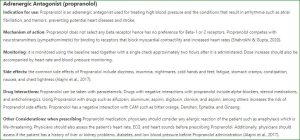Topic 2 DQ 2 Adrenergic Agonist or Antagonist 
Choose either an adrenergic agonist or antagonist agent and provide an appropriate indication for use. Share the mechanism of action of this medication and hints for monitoring, side effects, and drug interactions, including interactions with CAM.
Adrenergic Agonist or Antagonist
What other considerations need to be made when prescribing these medications in relation to other systems and receptors?
Discuss evidence and treatment guidelines to determine appropriate therapeutic options for a patient with a peripheral nervous system disorder. Include the name of the medication in the subject line so that the medications can be followed. Include references using APA format.
ALSO CHECK: PRESCRIPTION AND NONPRESCRIPTION MEDICATIONS/ THERAPIES PAPER 1
ORDER A PLAGIARISM-FREE PAPER HERE !!
Solution
Adrenergic Antagonist (propranolol)
Indication for use: Propranolol is an adrenergic antagonist used for treating high blood pressure and the conditions that result in arrhythmia such as atrial fibrillation, and tremors, preventing potential heart diseases and stroke.
Mechanism of action: Propranolol does not select any beta receptor hence has no preference for Beta-1 or 2 receptors. Propranolol competes with neurotransmitters (sympathomimetic) for binding to receptors that block myocardial contractility and increased heart rates (Shahrokhi & Gupta, 2020).
Adrenergic Agonist or Antagonist
Monitoring: it is monitored using the baseline read together with a single check approximately two hours after it is administered. Dose increase should also be accompanied by heart rate and blood pressure monitoring.
Side effects: the common side effects of Propranolol include dizziness, insomnia, nightmares, cold hands and feet, fatigue, stomach cramps, constipation, nausea, and chest tightness (Alajmi et al., 2017).
Adrenergic Agonist or Antagonist
Drug Interactions: Propranolol can be taken with paracetamols. Drugs with negative interactions with propranolol include alpha-blockers, steroid medications, and anticholinergics. Using Propranolol with drugs such as alfuzosin, aluminum, aspirin, digitoxin, clonixin, and aspirin, among others increases the risk of Propranolol side effects. Propranolol has a negative interaction with CAM such as bitter orange, Danshen, Ephedra, and Ginseng.
Adrenergic Agonist or Antagonist
Other Considerations: when prescribing Propranolol medication, physicians should consider any allergic reaction of the patient such as anaphylaxis which is life-threatening. Physicians should also assess the patient’s heart rate, ECG, and heart sounds before prescribing Propranolol. Additionally, physicians should assess if the patient has a history of liver or kidney problems, diabetes, and low blood pressure before Propranolol administration (Alajmi et al., 2017).
Peripheral neuropathy treatment: Peripheral neuropathy presence is due to damage to the peripheral nerves which leads to numbness, weakness, pain in the hands, and alters circulation, urination, and digestion. The condition’s diagnosis includes a physical examination of blood tests as well as full medical history and neurological examination. From a study, the most effective treatment for peripheral neuropathy is nortriptyline (antidepressant) (Ozmen et al., 2020). However, other medications such as topical treatments, anti-seizure medications such as pregabalin, and pain relievers are used for peripheral neuropathy. Therapies such as physical therapy, transcutaneous nerve stimulation, and surgery help alleviate the condition’s symptoms.
References
Al-Majed, A. A., Bakheit, A. H., Aziz, H. A. A., Alajmi, F. M., & AlRabiah, H. (2017). Propranolol. In Profiles of drug substances, excipients and related methodology (Vol. 42, pp. 287-338). Academic Press.
Ozmen, M. C., Dieckmann, G., Cox, S. M., Rashad, R., Paracha, R., Sanayei, N., … & Hamrah, P. (2020). Efficacy and tolerability of nortriptyline in the management of neuropathic corneal pain. The ocular surface, 18(4), 814-820.
Shahrokhi, M., & Gupta, V. (2020). Propranolol.
